In recent years, Japanese akoya pearls have become popular all over the world . No matter whether consumers in online or physical stores, they all love Japanese akoya pearls. Well known for their glowing luster, thickness >0.4mm and almost flawless surface. In layman term, they are like single round light bulbs, representing the beauty of oriental women.
Pearls enthusiasts definitely knows what the best Akoya Pearls are, and they are called Hanadama. Hanadama, meaning Flower Pearl, represents the highest quality available in Japanese Akoya Pearls, certified by the Japan Pearl Science Laboratory.
What is a TEN-NYO? TEN-NYO is the highest graded Pearls in the world (Previous highest was Hanadama). As a representative of high-quality akoya pearls, the word "TEN-NYO" is well known around the East.

But do you really know about TEN-NYO?
The word TEN-NYO can be directly translated as "A lady from heaven". TEN-NYO Pearls, must first qualify as Hanadama Pearls, and undergo additional stringent tests. The TEN-NYO is essentially a Hanadama but they are at the top of the grading scale. For a strand of pearls to be considered TEN-NYO, it must firstly be certified as Hanadama. Next comes the testing of the 'Teri'of the pearls to determine whether the strand of Hanadama pearls are worthy to be called TEN-NYO. Teri is the word for the light interference which occurs on the surface of the nacre. Testing of this Teri can only be done with a special device called the 'Aurora Viewer' and it is used to measure the intensity of iridescent colors of the pearls. Only when it gets scored more than 90% then can it be certified as true TEN-NYO pearls.
The standard of the TEN-NYO layer is 0.4mm. Those below 0.4mm cannot be evaluated as TEN-NYO. Many sellers claim that the thicker the layer, the better the luster, and many buyers take it for granted. However, it is not.
Magnification – Quality test on surface of the pearl, varies from "very slightly", "slightly" to "some". Colour varies from pink, pinkish green to green.
Inner Inspection – Thickness of pearl layers by optical fiber with a minimum of 0.40mm.
TERI Value Analysis – Light Interference Test, with a minimum score of 90%, known as the aurora effect to qualify as TEN-NYO Pearls.
Certified by Japan Pearl Science Laboratory, with high degree of recognition and level of technology to certify TEN-NYO Pearls.

It's not that the thicker the pearls nacre is, the better the gloss is. The thickness of the pearl nacre is not directly related to luster and blemishes. Then everyone should keep in mind that as long as TEN-NYO, the thickness has reached the standard of the Japanese pearl industry, which is more than 0.4mm.
The price of akoya pearls is still determined by the quality of the surface, rather than a single nacre thickness.

Here attached the website of Pearl Science Laboratory, and you guys who are good at Japanese can read them by yourselves.
http://www.sinjuken.co.jp/discrimination/aurora/list.html
Let's interpret the contents of the certificate.
The content on the left is from top to bottom: Pearl image, certificate number, pearl type, jewelry style, pearl size, and identification method.
The contents on the right are in order from top to bottom: Special Appellation, Thickness of Nacre, TERI Analysis, Brightness, Iridescent Color, Body color, Inperfection & Surface, Shape. The left side of the last column is the quality grade mark; the right side is remarks. The main information is the interference color image under the exposure of a professional instrument. Other information, for example, the first item is natural color, the second item is the inherent color of pearl layer. These two assessments depend on the circumstances. If the pearls are natural in color and your company asked to require natural in color certification, these two items will be added to the remarks column.
Speaking of grade markers, there are many gradations for Pearl Science Laboratory. We just need to remember the following two marks.

The mark on the left is the "highest quality" mark, and the mark on the right is the "strongest luster" mark. As long as these two marks are possessed, it is the highest quality pearl with the highest quality or the highest luster assessed by Pearl Science Laboratory certified.
As shown in the figure, here we explain the grade of certificates.
⭐Identification report of type - P
Type-P identification certificate is special for "Aurora Tennyo". The report describes TERI’s inspection result and attached aurora image. It is a kind of "Aurora Hanadama" in a broad sense.
Common Blemishes Found on Akoya Pearls
Many consumers believe that high-quality pearls should be flawless. A lot of people buy thousands of dollars worth of pearls and think I'm paying so much for them, they have to be flawless. Unfortunately, however, there really aren't so many perfect natural pearls. Consumers must understand that all natural pearls are slightly flawed. Perfectly flawless, only found in artificial pearls.
Especially as a necklace, which identification is not as strict as a single pearl. The pearl named TEN-NYO is the best among akoya pearls that can achieve flawless levels at normal social distance. It is unwise to picking single pearls blemishes on whole necklace.
The common blemishes of akoya pearls are: Dents/Divots, Knobs/Tips, Bulleting/Mottling, Clustered Pin Pricks.
Flawless pearls are rare. The highest quality akoya is generally sold in the form of a single pearl.Therefore, consumers should keep in mind that the necklace quality will be slightly lower than single pearl.

Mottling/Bulleting: This is a faint plating pattern on the pearl’s surface, and considered to be the result of very thick nacre accumulation. As such, this is not considered an inclusion per se, however many do find that this feature can mar the smooth surface of the pearls if found in abundance.
Clustered Pin Pricks: Tiny pin point indentations in the nacre, clustered together in small groups. If clusters are too numerous, the pearls can have a “chewed” appearance.
Mottling/Bulleting: A colorless feature, this type of growth characteristic does not impact the beauty of the necklace if found upon up-close inspection occasionally, and does not affect the long-term durability of the pearl.
Single Pin Pricks: Tiny pin point indentations in the nacre, isolated from any others. Tiny, and covered in the same color as the rest of the pearl’s nacre, pin pricks are often only distinguished upon up-close, careful inspection and do not impact the pearl’s durability or beauty.
Pearl Treatments and Enhancements
Large factories in Japan and China process pearls in bulk. Since these are the major producers of pearls, this results in uniform appearance and excellent matching for most pearl strands. After pre-treatment washing, most pearls undergo bleaching, dyeing, and a light polishing, and some types also receive luster enhancement. While many people view dyeing negatively, there’s little to no stigma associated with these routine pearl treatments.
Washing
Once out of the shell, pearls are tumbled in a mildly abrasive saltwater solution that removes stuck organic matter. After this step, experts grade the pearls, which determines their subsequent level of treatment. Only top-quality pearls receive no further treatment. (For Akoya pearls, for example, these are Hanadama-quality pearls). Sellers may also advertise other cultured pearl types as untreated.
It can be seen that akoya is more pink and brighter after toning. Toning technology is the core technology of every pearl processing company in Japan, which is very mysterious. They used black cloth to cover the windows in the factory floor, which is an important trade secret.
Comparing the PSL certificates of toning and non-toning Aurora TEN-NYO, the two lines marked by the red pen are the identification instructions for non-toning/Natural, which is the same as the non-toning Hanadama.

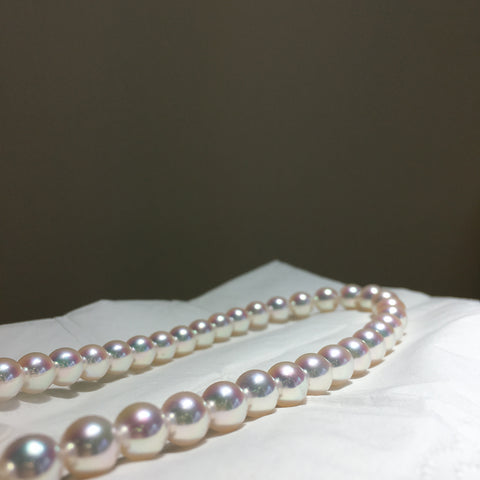
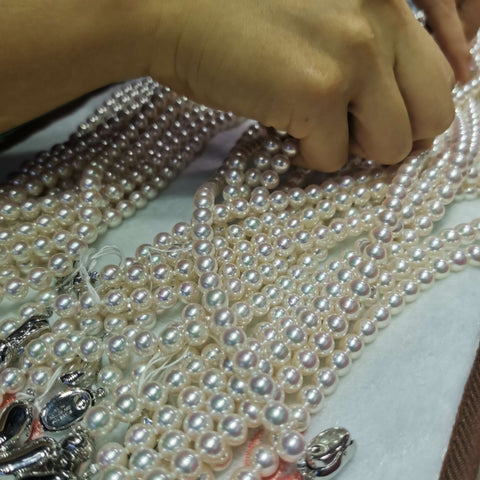


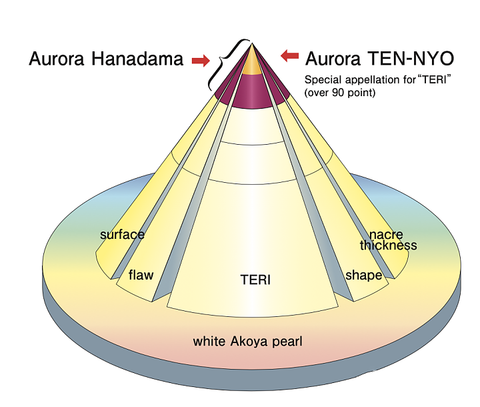
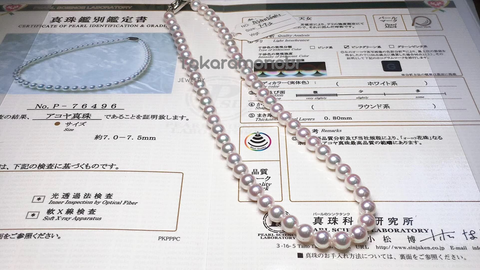

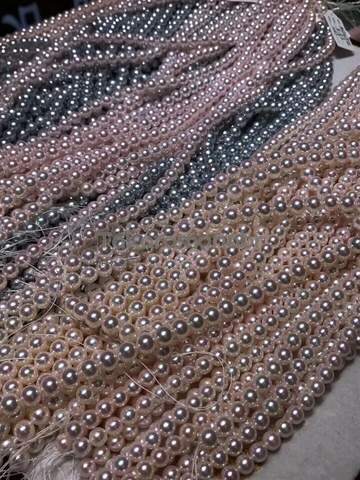







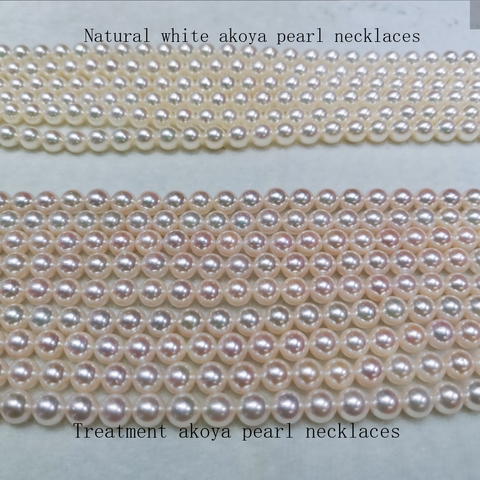


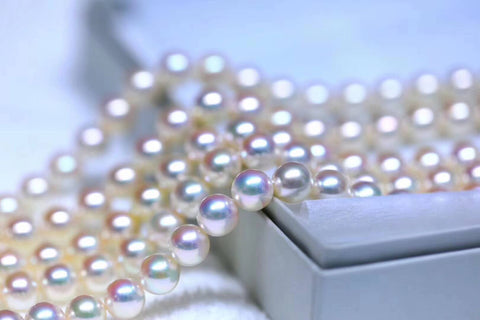

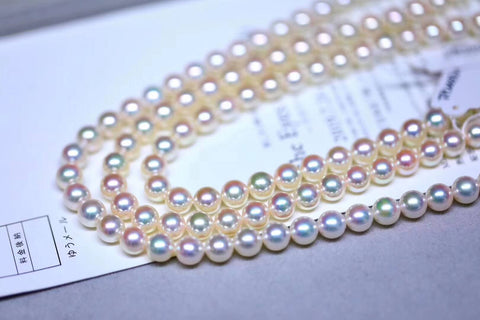


Dear reader,
Thank you for taking the time to read and leave a message.
Blue Rose is the second grade within the blue pearl color range, with Madama being the highest grade. Tennyo and Hanadama, mentioned in this article, are the highest grades within the white Akoya pearl color range. One can understand the ranking as Madama=Hanadama, Blue Rose=Rose. As for Tennyo, they are chosen from the top tier of Hanadama pearls. We hope this answer can solve any questions you may have. Please feel free to continue the discussion by leaving a message.
This article also includes some interpretations regarding PSL certification, provided solely for reference purposes.
https://takaramonobr.com/blogs/pearl-science-laboratory-akoya/how-to-read-the-different-akoya-certificates-for-pearl-science-laboratory
Thank you.
Thank you for explaining the quality of Akoya pearl so clearly. I want to invest in a good quality pearl necklace but I am still unclear about some of the description. Can you help? I have heard of the term “Madama” to describe Akoya pearls. What does it mean and how is it compared to Hanadama ? Also, I have seen the term “blue rose” on the certification but can not find any explanation anywhere. What does blue rose mean? Is it about the color? Thank you
Thank you
Leave a comment